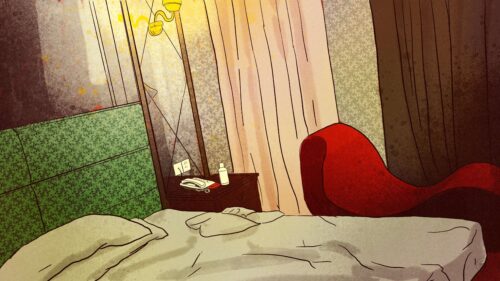This Week in China’s History: September 8, 1922
Xí Shàngzhēn 席上珍 was one of the modern women who exemplified Shanghai in the early 20th century. Educated in a progressive school for girls, she taught for a time, also publishing poetry and fiction in Shanghai’s multicultural society. She lived with her family in the formerly walled “Chinese city,” commuting each day through the streets of the French Concession into the International Settlement, the foreign-run enclave where she was the first woman to be employed by Shangbao, a newspaper aimed at the city’s Chinese-speaking business community.
She was 24 years old when, on the afternoon of September 8, 1922, she took her own life.
The death of Xi Shangzhen was a tragedy for her family and friends, but its significance soon transcended that circle. Historian Bryna Goodman, whose book The Suicide of Miss Xi, analyzes and illustrates the meaning of Xi’s death, describes how, within weeks, three books, hundreds of articles, and extensive coverage in Chinese, Japanese, and Western-language newspapers were telling the story of Xi’s death, and life. At a time when women’s political and economic autonomy was at the center of public debate, Xi’s life and death offered a prism through which to view complex questions of citizenship, gender, race, democracy, and colonialism.
Xi’s body was found by her sister and several co-workers. Something about Xi’s demeanor in the afternoon — including that she declined to eat with the rest of the office as was customary — had alarmed her colleagues, who contacted her family by messenger out of worry. By the time her sister arrived, Xi Shangzhen had hanged herself using the cord of an electric kettle.
China news, weekly.
Sign up for The China Project’s weekly newsletter, our free roundup of the most important China stories.
What had led an educated woman embarking on a promising career to such desperation? Shanghai had been recently rocked by a financial panic; Xi had lost a lot of money when the stock market she had invested in crashed. Those jumping to conclusions leapt there first.
The International Settlement’s Mixed Court ordered an inquest. Most foreigners in the Settlement were beyond Chinese law, living under extraterritorial protection, but Chinese in the Settlement were not, and so the court was an odd institution, applying Chinese law in an extraterritorial setting. Sitting on the bench, and trying the cases, was a multinational cast that existed in Shanghai and a handful of other colonial and semi-colonial settings around the world (historian Par Kristoffer Cassel’s Grounds of Judgment is the place to dig deeper into this institution).
The inquest affirmed the initial description of suicide, but testimony illuminated a scandal that grew the story far beyond a personal tragedy. Alongside Xi at the center of the turmoil was Tāng Jiézhī 湯節之, Shangbao’s managing director. Tang, who also went by Fred, or F.C., Tong, had been educated in the United States, at UC-Berkeley, and made a name for himself after his return to Shanghai in the May Fourth Movement of 1919. “As the movement subsided,” Goodman writes, “Tang redirected his political acumen and expansive social and commercial ties into the establishment of a progressive newspaper.” It was that newspaper — Shangbao — that hired Xi Shangzhen as its first female employee.
Women in the workplace was controversial, and for the first woman at a reform-minded newspaper to die by suicide at the office was jarring, but it got worse when the testimony suggested that the death at Tang’s paper was not coincidence. Money did seem to be at the root of Xi’s despair, but it went beyond that. Xi’s mother, sister, and sister-in-law testified that Tang Jiezhi had borrowed money — a lot of money — from Xi, promising to invest it in the bull market and make them both rich. For more than a year, she had tried to get her money back, never mind the returns. Xi’s family went on to suggest that Tang was using the money he had extorted for sex, pressuring Xi Shangzhen to become his mistress. The pressure had driven her to desperation more than once: this had not been her first suicide attempt.
Tang rebutted that he was trying to use his investment experience to help Xi make money, the same way that he had helped other employees before. But by the time he had taken Xi’s money to invest, it was too late: the market soon crashed, and the shares he had bought for her were now worth far less than the initial investment. He squarely rejected the suggestion that he had propositioned Xi Shangzhen, and produced a promissory note for 5000 yuan (hard to compare, but that might be about $30,000 today). This IOU, Tang testified, was kept in a safe as assurance that Xi would get her money back. Rather than extorting her, he argued, he was going beyond the strict terms of their transaction by promising to make good Xi’s losses, which had occurred through the vagaries of the market.
The story was tailor-made to illustrate the social upheaval wracking Shanghai — and, by extension, China — at the time. The public ate up books, editorials, illustrated supplements, news reports, and essays providing details, and judgments, about the case. Some portrayed Xi as a representative of Chinese virtue done in by madcap capitalism in a dangerous foreign-inflected city. Goodman describes one elegy that compared Xi Shangzhen to Qiū Jǐn 秋瑾, the revolutionary martyr killed by Qing soldiers two decades earlier. Other stories, especially in the tabloid media, elaborated on the accusations of sexual impropriety.
Editorials revisited the questions of women’s suffrage based on the case. Surely Xi represented the perils facing women in the workforce, especially without equal citizenship that could come with voting. Others took the view that this affirmed the need for more traditional roles, arguing that Xi’s death was a tragic but predictable outcome of women moving into traditionally male realms.
But whichever of the several sides was taken, it seemed that the legal process for Xi’s case was ended.
That changed dramatically in November, two months after the suicide, when Chinese police arrested Tang Jiezhi. Although Tang lived, and worked, in the International Settlement, where Chinese jurisdiction was limited, Chinese prosecutors arranged to arrest Tang when he parked his car on the boundary of the settlement. Just feet away from safety “when Tang parked his car at 2 a.m.,” Goodman writes, “the [Chinese] police pounced, overpowering [Tang and his driver], whom they delivered to the Chinese jail.”
After a month-long trial, a judge convicted Tang of fraud and sentenced him to three years in prison.
The case of Xi Shangzhen and Tang Jiezhi is a small window onto a complex moment. Of course, it doesn’t carry the weight of mass protests or broad social movements, not to mention revolutions or wars, but it is a moment that can teach a lot. As historian Goodman writes, the case “illuminates a moment, after the fall of empire and before the rise of central party rule, when urban Chinese improvised practices of liberal democracy in public life.”
Today, we exist in a moment when questions of democracy, gender roles, the workplace — among many others — remain central. Perhaps that makes this an especially appropriate time to revisit what Goodman referred to as this “tenuous, if ill-fated, moment of possibility between empire and party dictatorship.”
This Week in China’s History is a weekly column.






